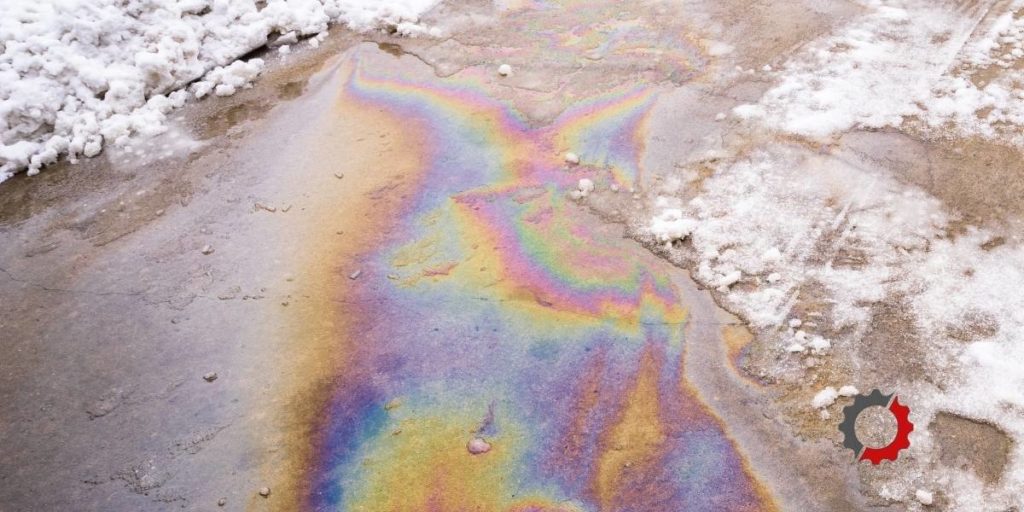You may notice gas leaking in the snow or the smell of gas fumes in your garage. Your snowblower is leaking gas, but you’re not sure where it’s coming from. Finding a leak can be a little tricky especially if the wet spot is mixed with melting snow or the gas evaporates and leaves no sign of a wet spot.
A Craftsman snowblower leaks gas from a bad carburetor gasket; stuck carburetor float or float needle; cracked fuel line; deteriorating fuel tank; bad fuel shut-off valve; bad fuel cap seal; degraded fuel filter; or weak primer bulb.
Before you begin working on your Craftsman snowblower, follow the safety precautions found in your operator’s manual. This includes shutting off your snowblower and removing the spark plug wire before performing repairs.

This post may include affiliate links. Purchases made through these links may provide a commission for us, at no extra cost to you. As an Amazon Associate, we earn from qualifying purchases.
Follow all safety instructions provided in your equipment operator’s manual prior to diagnosing, repairing, or operating.Consult a professional if you don’t have the skills, or knowledge or are not in the condition to perform the repair safely.
9 Reasons Your Craftsman Snowblower Leaks Gas
Carburetor Bowl Gasket on a Craftsman Snowblower
A common place for a leak to develop is from the carburetor bowl. The bowl is located at the bottom of the carburetor. This is where a little gas is stored after it leaves the fuel tank.
A small gasket that looks like a rubber band is used to seal the carburetor bowl to the carburetor. Because of its close proximity to the engine, it can become dry, brittle, and prone to failure.
The gasket is stressed regularly when the engine heats up and then cools down. This extreme temperature change will cause the gasket to eventually dry out, become hard, and no longer seal sufficiently.
Replacing the small rubber o-ring gasket at the bottom of the bowl is a very simple process.
You will need to get the make, model, and spec number off of the engine and take it to your local dealer to get the correct o-ring gasket for your snowblower.
This number is different from the model and the serial number of the snowblower.
- Once you have the replacement gasket, shut off the fuel supply to the snowblower. Use the fuel-shut-off valve located at the bottom of the fuel tank or hose pinch pliers to crimp the fuel line.
- Wipe around the carburetor so you don’t introduce any dirt to the carburetor when you remove the bowl.
- Unscrew the screw at the bottom of the carburetor and drop the bowl down.
- Replace the gasket and reinstall the bowl and the screw.
- Turn the fuel back on and wipe down the carburetor bowl and make sure there are no more leaks.
Stuck Float on a Craftsman Snowblower
If you still find leaks coming from the carburetor and they are not coming from a bad carburetor bowl gasket, take a look at the opening of the carburetor by the air intake port.
The float can become stuck allowing fuel to overflow and run out of the carburetor. The float’s function is to regulate how much gas is stored in the carburetor bowl.
When it doesn’t function because it becomes stuck from old fuel deposits, the carburetor will need to be disassembled and cleaned.
If you are a little mechanical and don’t mind working with small parts, you can use my instructions at the bottom of the page to clean the carburetor.
Otherwise, take the snowblower to your local small engine repair shop to have a mechanic clean or rebuild the carburetor.
Stuck Float Needle on a Craftsman Snowblower
In addition to a stuck float, you will need to look at the float needle. This is what really keeps the gas flowing into the bowl along with the help of the float. The needle can become stuck.
You can try to free up the needle by tapping the carburetor with a rubber mallet or the rubber handle of a tool. This may work once or twice, but this is only a temporary fix.
You will need to remove and rebuild the carburetor to get it functioning properly.
Cracked Fuel Lines on a Craftsman Snowblower
The fuel lines dry out over time and develop cracks. They can also begin leaking where clamps are used to hold the lines to the fuel components.
Follow the fuel line out of the tank to the carburetor to inspect the fuel line and look for any cracks or punctures causing fuel to leak from your Craftsman. Replace any damaged lines.
Replace a Craftsman snowblower fuel line:
- Turn off the fuel supply using the fuel shut-off valve located at the bottom of the fuel tank. If you don’t have a shut-off valve on your snowblower, use pinch pliers to crimp the fuel line to stop the flow.
- Remove the clamps securing the fuel line in place. Remove the fuel line.
- Install clamps and a new piece of fuel line of the same diameter and length as the line removed.
- Turn on your fuel flow.
Deteriorating Fuel Tank on a Craftsman Snowblower
A Craftsman fuel tank can begin to degrade causing a fuel leak to develop. You may have a steel or a polyethylene tank.
If you have an older snowblower with a metal fuel tank, inspect the tank for a small rust hole. If you have a poly tank, check the seams where the plastic is molded together. The seams can fail and begin leaking.
Replace the fuel tank when you find a leak. If you find you have an older metal fuel tank that is no longer made, use a product like JB Weld to repair the fuel tank.
Leaking Fuel Valve on a Craftsman Snowblower
Some Craftsman snowblowers have a fuel shut-off valve. They are typically located near the bottom of the fuel tank. Some valves are plastic while others are metal.
Both styles are prone to leaking. Replace a leaking fuel shut-off valve.
Degraded Fuel Filter on a Craftsman Snowblower
A fuel filter is used to keep contaminants from entering the fuel system and causing wear on the engine. Some Craftsman snowblowers use a fuel filter attached to the fuel line and placed inside the fuel tank.
Others will use a plastic filter attached to the fuel tank or placed between the fuel lines. The plastic filter can degrade with time causing it to become weak and begin leaking at the seams.
Replace a leaking fuel filter. Be careful when removing it as the plastic will be weak. The best way to avoid this problem in the future is to replace your fuel filter regularly.
Bad Gas Cap on a Craftsman Snowblower
As you use your Craftsman snowblower, gas sloshes in the fuel tank. If the seal in the cap isn’t sealing well, the gas that splashes up to the cap can leak out of the cap area.
You may not see a wet spot around the fuel cap if it’s been a while since you last ran your snowblower. This is because gas will evaporate.
If you continually smell the gas but never find the source, there’s a good chance it could be your fuel cap. The gas evaporates around the leaking area before you get to see it leaking.
A good thing to do to identify a bad cap is to gently rock your snowblower to get the fuel to splash around the cap area to see if you develop a wet spot around the cap.
If you do see fuel around the cap you need to replace it with a new gas cap.
Weak Primer Bulb on a Craftsman Snowblower
Some snowblowers will have a primer bulb to prime the carburetor when starting the snowblower. The primer bulb can leak fuel when the bulb fills with fuel.
Other times, you will find a leak where the primer bulb connects to the fuel line or when the primer bulb becomes weak and brittle.
Steps to Clean Your Craftsman Snowblower Carburetor
1. Spray Carb Cleaner to Minimize Carbon Buildup
Spray some carburetor cleaner in the air intake. Start the engine to see if it will run. If your snowblower fires up and still won’t stay running then we need to get inside the carburetor.
2. Gather Pliers, Screwdriver, Sockets & Ratchets
Get together tools so you don’t destroy parts while taking the carburetor apart.
3. Take a Photo for Reassembly
These days most people have a handy camera on their phones. It’s a very good idea to take a picture of the carburetor so you can refer to it if you don’t remember how to reassemble it after tearing it apart.
You will want to make sure you get a photo showing how the linkage and springs go back on the carburetor.
4. Remove Throttle Cable & Choke Cable
Not every snowblower has a throttle and choke cable. If your snowblower does, remove the cables at this time.
5. Remove Springs
Slowlyremove the springs so you don’t stretch them out too much. You may have to twist the carb a bit to get the springs off. Also, watch the gasket at this point so you don’t tear it.
This is the gasket located between the engine block and the carburetor.
6. Remove Screw Off Float Bowl
The float bowl is where gasoline is stored inside the carburetor. It should have gas in it so have a rag ready to catch the gas. Remove the screw at the bottom of the bowl
7. Remove Bowl
Remove the bowl being careful to not damage the o-ring around it. Caution: Do not get any carb cleaner or any other chemical on the o-ring. It will stretch out and you won’t be able to reuse it.
8. Inspect the Stem for Clogged Holes
Inspect the stem for clogged holes. This stem hangs down from the center of the carburetor and has holes in it. If these holes get plugged from old fuel it will not draw fuel up to the jet.
If the holes are plugged, take a thick wire to clean them out. It’s easier to see what you’re doing if you use a flashlight. Once you get the holes clean you can rinse them with carb cleaner.
9. Inspect the Carburetor
Inspect the carburetor for hard crusty white buildup. This white buildup is fuel additives including ethanol. You need to try to get as much of the white power material out as you can. It’s nearly impossible to get it all out.
10. Reassemble the Carburetor
Reassemble the carburetor now that the carb is clean. Put it back to together in the reverse order you took it apart. Remember to refer to the photo you took of the carburetor when reassembling so all parts are reinstalled in the right places.
11. Add Fuel Supply with Fuel Stabilizer
Add a new fuel supply that contains and fuel stabilizer before you start your snowblower. Pour the fuel into the tank and give it a chance to fill the bowl of the carburetor.
Start your engine. If you are starting with a pull cord, give the rope a yank. It may not start on the first pull, but it should start after several pulls and continue to run.
I go into more detail about fuel stabilizers and the one I like best in “The Best Fuel Additive for Your Snowblower”
Use the Right Kind of Gas & Stabilize It for Best Performance
Gasoline can degrade the fuel system causing fuel component failures and leaving behind gummy deposits that can create fuel restrictions and running problems.
Find out more about the right type of gas for your Craftsman snowblower along with steps to stabilize it to keep it from breaking down and becoming less effective: This is the Gas to Use In a Craftsman Snowblower.
